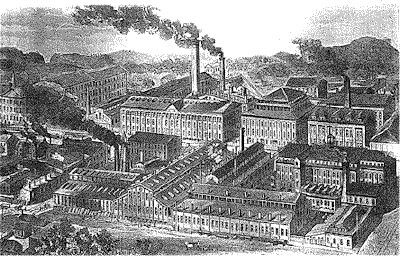Reading the Landscape
 Rogers Locomotive Works, Paterson, New Jersey.
Rogers Locomotive Works, Paterson, New Jersey.From Protecting Cultural Landscapes: Planning, Treatment and Management of Historic Landscapes by Charles A. Birnbaum, ASLA (Preservation Brief 36, National Park Service):
A noted geographer, Pierce Lewis, stated, "The attempt to derive meaning from landscapes possesses overwhelming virtue. It keeps us constantly alert to the world around us, demanding that we pay attention not just to some of the things around us but to all of them--the whole visible world in all of its rich, glorious, messy, confusing, ugly, and beautiful complexity."
Landscapes can be read on many levels--landscape as nature, habitat, artifact, system, problem, wealth, ideology, history, place and aesthetic. When developing a strategy to document a cultural landscape, it is important to attempt to read the landscape in its context of place and time.
Reading the landscape, like engaging in archival research, requires a knowledge of the resource and subject area as well as a willingness to be skeptical. As with archival research, it may involve serendipitous discoveries. Evidence gained from reading the landscape may confirm or contradict other findings and may encourage the observer and the historian to re-visit both primary and secondary sources with a fresh outlook. Landscape investigation may also stimulate other forms of research and survey, such as oral histories or archeological investigations, to supplement what appeared on-site.
The North Jersey Herald has an article, "Hoping history repeats itself" about the development of a nascent heritage area (although they don't seem to be grasping that) focused around the industrial heritage of Paterson, New Jersey. Paterson was the founding location for "import-substitution industrialization" developed by Alexander Hamilton and others starting in 1791!
The website Paterson Friends of the Great Falls outlines their proposal. It's another example of thinking broadly about the cultural landscape, or using the "heritage area" concept to consider, develop, and manage heritage assets. Such made up many of the presentations at the National Main Street conference.
Index Keywords: cultural-heritage-tourism



0 Comments:
Post a Comment
<< Home